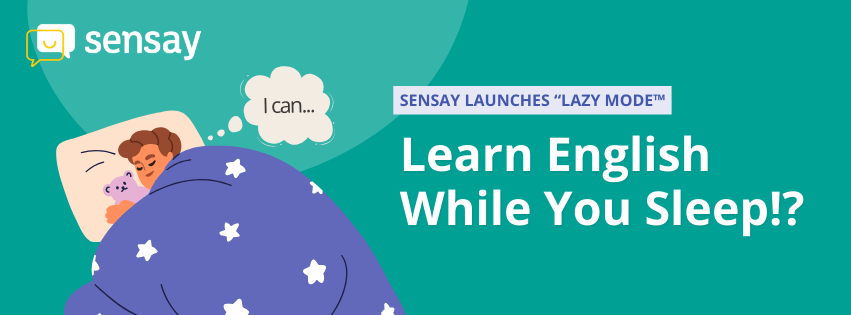Dear Teachers,
Have you ever wished students would practice English without constant reminders? Well, dream no more—because Sensay is making it a reality!
Introducing: 🎉 Sensay Lazy Mode™ 🎉
After countless hours of innovation, we’ve developed the ultimate AI-powered subconscious learning tool. Simply rest your head on our smart pillow, and English fluency will sink in overnight!
😴 How Does Lazy Mode™ Work?
Thanks to our latest AI subconscious audio-learning technology, students can now absorb English sentences in their sleep — just by resting their heads on a smart pillow. Yes, a real pillow!
🛏️8 hours of sleep = the equivalent of 4 full English lessons a day!
🎧 Simply log in to Sensay and follow these steps:
- Activate Lazy Mode before bedtime
- Choose a daily topic (e.g., greetings, ordering food, confessing love)
- Lie down and drift into dreamland
- Wake up saying: “Can I have a cheeseburger, please?”
⚠️ Important notes:
- If a student accidentally speaks fluent English in their sleep, please let them to brag a little 😎
- If they start reciting English dialogues in their dreams, that’s completely normal — don’t interrupt the process
- If you notice students can’t stop speaking English after using it… maybe reduce the frequency a little
🙊 You don’t have to “sleep to learn,” but you can laugh while learning!
Of course, Lazy Mode™ is just an April Fools’ Day fantasy 😄 But what’s real is this:
✔️Real-time AI feedback
✔️Building students’ speaking confidence step-by-step
✔️Daily 5-sentence speaking practice (for certain districts)
We know teachers are busy—preparing lessons, leading activities, managing class progress… it’s not easy. That’s why, for this special occasion, we’ve also prepared themed content and classroom ideas, so you can turn April Fools’ Day into a fun and meaningful learning moment!
📚 Quick Fun Fact: The Origins of April Fools’ Day
April Fools’ Day can be traced back to 16th-century France, when the New Year was moved from April 1 to January 1. Some people kept celebrating in April and were mocked as “April Fools.” Another origin comes from the Roman festival Hilaria, where people wore costumes and played pranks to celebrate the arrival of spring.
No matter the version, one thing is clear:
April Fools’ Day reminds us that facing change with humor is a powerful form of learning.
💡 Pro Teaching Tips: Fun English Activities for April 1st
Make April Fools’ Day a chance for students to speak more English with fun, low-pressure activities:
- 🎭 Silly Sentence Challenge – Have students make up a funny sentence (e.g., “I saw a flying cat this morning!”).
- 🗣️ Prank the Teacher – Pair up students to create a short dialogue in English for a harmless classroom prank.
- 🙃 The “English Lying Game” – Start each sentence with “This is not true, but…” and see who can tell the funniest (fake) story.
- 🏆 Group Challenge – Who can tell the best joke in English?
Using humor and creativity often helps students open up and speak more confidently!
🎁 Free Sensay Practice Pack
We know how busy teachers are — That’s why we’ve prepared an April Fools’ edition Sensay Practice Pack to make things easier!
📦 Just log in to download for FREE!
💬 One Last Thing for Our Amazing Teachers:
Helping students explore language, express themselves, and build confidence — that’s the greatest gift a teacher can give. To every educator working hard on the frontlines: We hope you find a little extra joy, creativity, and laughter in your classroom today.
Let’s turn “I don’t understand” and “I don’t know how to say it” into “I get it!” and “I can say it out loud!” — together 💪
Happy April Fools’ Day, and Happy Teaching! 🌟
#Sensay #AprilFools #EnglishTeaching #EdTech #DailyEnglish #TeacherResources #FunInTheClassroom

